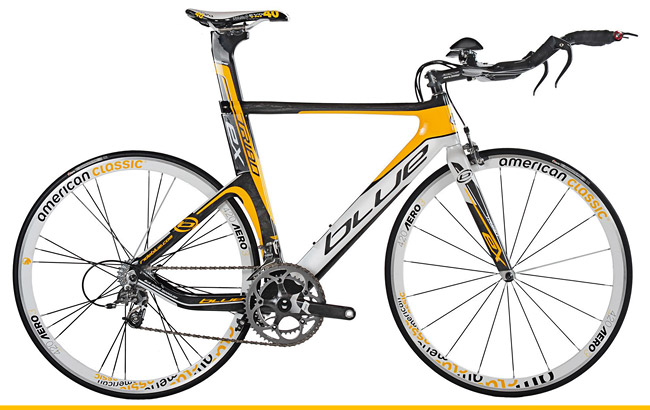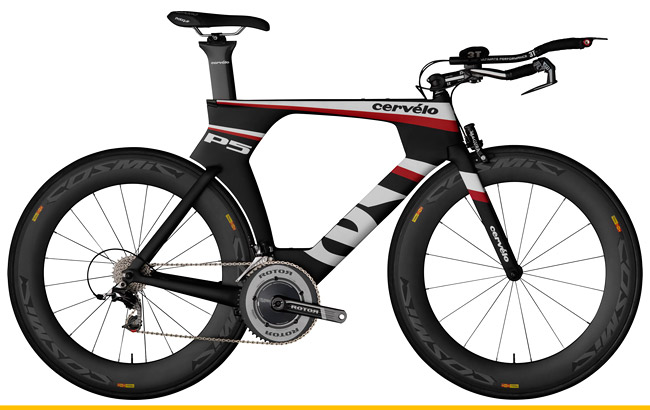The Best Triathlon Bikes for Every Rider 最佳铁三自行车选购
Any old road bike will do for a triathlon. Hell, we’ve seen a Taft-esque man lumber through a sprint on a mountain bike. But if you want to be in the optimal position for performance in a multi-sport race, to thrive in long course and ultra-distance races, then a bike with a triathlon-specific designbecomes important. You’ve got to get aero. You’ve got to cheat the wind. You’ve got to avoid the recruitment of fast-twitch muscle fibers. You’ve got to pick up chicks on account of your sick superbike. We’re here to help.
Editor’s Note: bikes fit differently across brands, even if they’re the same size. Test out different bikes before buying one — and then have yours custom fit by a professional.
Blue Triad EX
Best Young Gun: Blue is a relatively young bike company run by the former Kestrel CEO, Steven Harad. Compared to other tri bikes, the Triad has a tall stack measurement (how far the bottom bracket sits below the frame’s head tube) and narrow reach (how far the head tube sits in front of the bottom bracket). Why does that make sense for the triathlete? “For us it’s about combining aerodynamics, which we’re really good it, with — and this is just as important — building triathlon bikes, not time trial bikes,” Harad says. “The triathlete has to get off that bike and run after their long ride, so our geometry is a much higher stack bike, really designed for rider’s comfort. I can get everybody aero, aero, aero, but if you can’t get off the bike and run afterwards you’ve got a useless bike”. This works out well for amateurs, most of who won’t have the flexibility to ride a super aggressive geometry. Combine the fit with SRAM Force components and a paint job suitable for a fighter plane, and you’ve got a pretty stellar triathlon setup.
Cervélo P5 Three
Best Updated Classic: Canada-based Cervélo is the brand of bike you’re most likely to see racked at any Ironman T1, and the original P2 remains one of the most iconic bikes in the sport. With the P5 Three they’ve created a bike so smooth and sexy you want to just caress it and lay with it and, well, ride it. With the P4 (the previous iteration of the bike), the goal of making a faster bike began to compromise some of its functionality — brakes hidden under the chainstays, mechanical linkages, internal cables — making hard to work on. “We decided for the P5 that we would adopt not only the traditional mantra for Cervelo — help our athletes go faster — but also reintroduce some simplicity into engineering and design the bike”, Damon Rinard, Senior Advance R&D Engineer at Cervelo, says. “So the P5 mantra became, simply faster”.
Of note with the much-hyped P5 is a carbon frame designed using the same Computational Fluid Dynamics software used by F1; Magura hydraulic rim brakes that are simultaneously lighter and more powerful than mechanical brake systems; a highly adjustable aerobar and completely hidden cables; standard headset parts and stem compatibility; and a battery of storage options designed to minimize aero drag. All of that adds up to a bike that’s easy to maintain, easy to travel with, and still faster than ever.
Parlee TTi
Best Bike from a Former Boat Builder: You won’t see wildly-shaped tubs on a Parlee bike. “Efficiency is the guiding principle behind all Parlee bikes” according to the Massachusetts-based company. Bob Parlee, the owner, spent 20 years in the boat-building business before moving on to racing bikes. The TTi is his third-generation tri-specific bike, and what it brings to the table — aside from being a fine looking machine — is what Parlee says is higher efficiency than competitors in a greater range of wind conditions (or “yaw angles”). Less drag in a wider range of yaw angles means better performance. A new fork was added from the previous iteration to improve aerodynamics, and like the previous version, the TTi has lots of options to adjust stack and reach position.
Orbea Ordu Gli2
Editor’s Choice: Orbea began as a rifle and gun producer in Spanish Basque Country in the mid-19th century. Today they make weapons of a different sort: very fast bikes. Three-time Ironman World Championship winner Craig Alexander rode an Orbea for years before switching to Specialized. This Ordu is the second iteration of their triathlon-specific frame, updated with two fork options (one UCI-legal, the other not), a frame that accepts both cable-actuated and electronic shifting, a rear brake tucked underneath, more damping in the rear stays and a host of fit options for riders of different sizes and preferences thanks to the Monolink stem and saddle systems. “It’s a really easy package to find the right fit”, Scott Warren, Orbea’s Product Manager, says. “In fact, even when you’re out on the road, if you have an allen wrench or a multi-tool you can stop, adjust the bars and try another position”. The Gli2 comes with the highly praised Shimano Ultegra Di2 component group, which shifts so smooth you’ll think you’re playing a video game. Just don’t forget it’s the real deal when you’re bombing hills at 45 MPH.
Quintana Roo Seduza
Best Value: It’d be a shame to talk tri bikes without mentioning Quintana Roo, the first company to make a triathlon-specific wetsuit and bike, both in the late ’80s. (For further, very dense triathlon reading, check out slowtwitch.com, a website founded by Dan Empfield, who started QR.) QR bikes are built for the multi-sport athlete, and the Seduza specifically targets the athlete who values a more conservative, comfortable aero position on the bike and wants it at an affordable price. They accomplish the former by increasing the headtube length and the latter at the two grand price point. Not that $2,000 is cheap, but between the frame and a component group that includes some Ultegra, it’s an excellent option for most age-groupers.
- 科隆/可隆 KolonSport 双肩摄影包 KEPX09631 测评报告
- 发布于 09月04日
- Jack Wolfskin男款多功能软壳冲锋衣体验评测报告
- 发布于 09月04日
- #EDC大晒#灰鸡宫城狮的EDC装备
- 发布于 08月08日
- 户外、生存你缺一把三刃木S738——使用感受小记
- 发布于 12月18日
















评论已关闭。